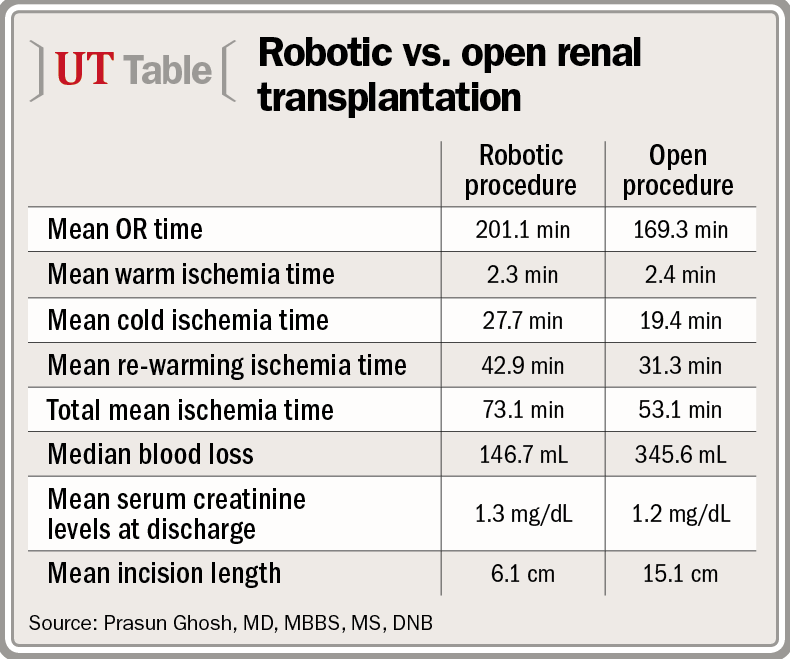Article
Robotic kidney transplant continues to show benefits
An international team of surgeons from the U.S. and India continues to explore the potential of robotic kidney transplantation with regional hypothermia. The results of an IDEAL (Idea, Development, Exploration, Assessment, Long-term) phase IIb trial of the procedure support the promise seen in preceding trials.
Taipei, Taiwan-An international team of surgeons from the U.S. and India continues to explore the potential of robotic kidney transplantation with regional hypothermia. The results of an IDEAL (Idea, Development, Exploration, Assessment, Long-term) phase IIb trial of the procedure support the promise seen in preceding trials.
RELATED: RARP checklist assesses, evaluates surgeon progress
"When we analyzed our data, we found that the patients who underwent a robotic kidney transplant had significantly lower analgesic requirements and that blood loss was significantly lower," first author Prasun Ghosh, MD, MBBS, MS, DNB, told Urology Times.
"There were no wound infections and there were no lymphoceles. These are substantial benefits seen in the robot arm," said Dr. Ghosh, senior consultant in urology and robotics and head of renal transplant at Medanta The Medicity Kidney & Urology Institute, Gurgaon, India.
"The low morbidity and comparable graft outcomes offered by this procedure may actually encourage chronic kidney disease patients to consider a preemptive transplant and subsequently reduce dialysis costs," he observed.
At the time of the presentation at the World Congress of Endourology and SWL in Taipei, Taiwan, patients had been followed for 6 months.
The prospective two-armed non-randomized trial consisted of 225 patients, 50 of whom underwent the robotic procedure and 175 of whom underwent the standard open procedure. Demographics in the two groups were similar. Mean age in the robot group was 37 years compared to 39 years in the open group. The majority of the patients were men, who constituted 75.9% of the robot group and 80% of the open group.
Origins of kidney failure included diabetes mellitus, hypertension, chronic glomerulonephritis, IgA nephropathy, interstitial nephritis, obstructive uropathy, and autosomal dominant polycystic kidney disease. There was one case of kidney failure of unknown origin in the robot arm and 12 such cases in the open group. The Charlson morbidity index was nearly the same in both arms-3.7 (SD, 2.1) in the robot arm and 3.2 (SD, 2.1) in the open arm.
Next: OR time longer with robotic procedure
More about robotics
RARP: ‘Little clear benefit’ compared to open surger
Protective patch linked to erectile function recovery
Robotic radical nephrectomy: There is a rationale
OR time longer with robotic procedure
The operating time in the robotic procedure was significantly longer than in the open procedure, with a mean time of 201.1 minutes (range, 156-296 minutes) with the robot compared to a mean of 169.3 minutes in the open group (range, 105-263 minutes).
Ischemia times (IT) were slightly longer in the robot arm. In these patients, the mean warm IT was 2.3 minutes (range, 1.3-6.0 minutes), the mean cold IT was 27.7 minutes (range, 10-90 minutes), and mean re-warming IT was 42.9 minutes (range, 27-66 minutes) for a total mean IT of 73.1 minutes (range, 50.7-142.5 minutes).
In the open group, the mean warm IT was 2.4 minutes (range, 1.5-4.5), the mean cold IT was 19.4 minutes (range, 9.0-36.5), and mean re-warming IT was 31.3 minutes (range, 24.0-44.0) for a total mean IT of 53.1 minutes (range, 40.6-78.8), or roughly 20 minutes shorter than that of the robotic procedure.
"There is no doubt that the vascular anastomosis is the most challenging aspect of the robot procedure," said Dr. Ghosh.
Despite the challenge and length of the robotic procedure, blood loss was significantly lower. The median blood loss in the robot arm was 146.7 mL (range, 50-450 mL) compared to 345.6 mL (range, 100–1,200 mL) in the open group. Mean serum creatinine levels at discharge were 1.3 mg/dL in the robotic group and 1.2 mg/dL in the open group.
The mean incision length in the robot arm was 6.1 cm (range, 5.4-7.1 cm) compared to 15.1 cm (range, 13.4-16.2 cm) in the open procedure.

"We found the postoperative pain and analgesic requirements for those in the robot group were significantly lower than those who underwent the open procedure," Dr. Ghosh said.
As Dr. Ghosh noted, no lymphoceles were found in the robotic procedure patients on non-contrast computed tomography scans taken at 3 months post-op. Lymphoceles were detected in 42 patients (24%) undergoing the open procedure. The U.S. team was headed by Mani Menon, MD, of Henry Ford Hospital’s Vattikuti Urology Institute, Detroit.
Subscribe to Urology Times to get monthly news from the leading news source for urologists.
Newsletter
Stay current with the latest urology news and practice-changing insights — sign up now for the essential updates every urologist needs.
















